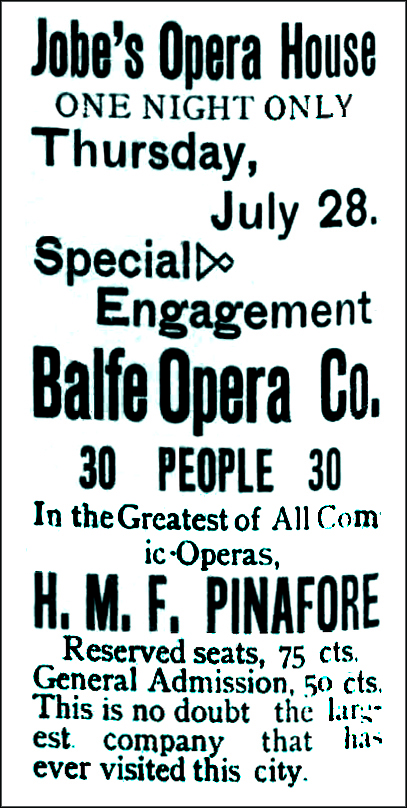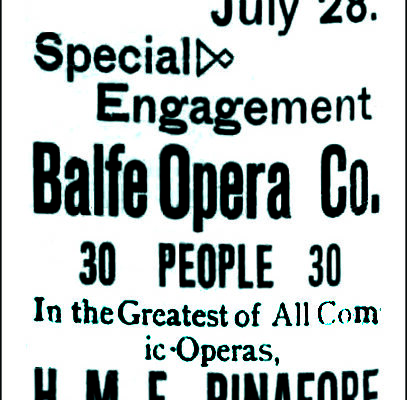In August 2006, I wrote an article about Jobe's Opera House, a former popular entertainment venue once located at the corner of E. Main and Spring streets on the second floor above Gump Brothers, a fashionable clothing store. Today's column provides supplementary information about the once popular establishment.

If we were to turn the clock back to 1890 in Fountain Square, there could be no mistake as to the identity of the business at that site. “Jobe’s Opera House” (see photo) appeared in sizable letters across the upper south side of the edifice, denoting Johnson City’s first public entertainment establishment. Ike T. Jobe built and managed the upstairs business; M.E. Gump was assistant manager and owner of Gump Clothing Store below.
The successful enterprise was proclaimed by a travel agent of McElreth’s Dramatic Troop to be the “largest and best hall between Lynchburg, Virginia and Knoxville, Tennessee.” A flyer from 1888 proclaimed: “Full Sets Scenery, First-Class Show Town, Play Companies Only on Shares,” with an added suggestion for patrons to “Stop at Piedmont House,” which was located nearby.
The enterprise offered cultural refinement from a variety of choices – operas, plays, lectures, humorists and music productions.
Entrance to the theatre was gained by entering Gumps through two doors on the Main Street side and climbing stairs into the auditorium. The lecture hall’s use also included sporting activities and even once served as a courtroom for chancery court sessions. In its formative years, the facility was used by such notables as Johnson City’s “Our Bob” Taylor, delivering lectures as part of his highly well-liked “The Fiddle & the Bow” series.

According to the late historian, Dorothy Hamill, the opera house occasionally opened its doors for high school graduations. Seniors, dressed in long white frocks or black suits, marched a short distance from “The Hill” on Roan Street to Jobe's Opera House where they received their diplomas.
Over time, numerous first-rate productions graced the opera stage, such as “Jesse James,” 1885, a production denoting the life of the infamous outlaw. Others appear as photos in this article.
The latter’s appearance was sponsored by the Longfellow Literary Circle and S.B. McElreth, a Johnson City comedian. This society was organized at the residence of Sallie Faw. Cargilles frequently sponsored such events, bragging that he owned “the cheapest store in existence.” Around the turn of the century, the opera management pioneered some brief action-packed silent motion pictures using a new invention – a hand-operated projectoscope.
The new medium of motion pictures was looming on the horizon and, by about 1907, would bring to an abrupt halt the once impressive opera house. As business waned, the second floor was divided into several small offices and rented until the building was finally razed and rebuilt.
An out-of-town reader of my column, who requested that I identify him only as Mr. John Doe, was thumbing through the fourth volume of an 1899-1900 “Official Theatrical Guide Containing Information of the Leading Theatres and Attractions in America.” John spotted an entry that he was certain would seize my attention. He was right; it offered some added specifics of Jobe's Opera House.

I am listing it just as it appears in the guide:
“Johnson City- Pop., 4169. Jobe's Opera House. Gump & Mathes, mgrs. and bus, mgrs. S.c. 606. Illum., elec. Wiley Porch, stage carp. Width prosc. opening. 20 ft. Height. 14 ft. Depth footlights to back wall, 22 ft. Depth under stage. 4 ft. 1 trap, located center. Theatre second floor. Wiley Porch, prop. man. Printing required, 3 stands, 2 3-sheets, 50 1-sheets, 50 1/2 half sheets. Wiley Porch, bill-poster.
Other information included: “Newspapers- “Comet,” weekly, Wed. “Staff,” weekly, Thurs.
“Hotels- Piedmont, Greenwood, Carnegie, special rates.
“Railroads- So., T. Klepper, agt. E.T.&W.N.C., J.C. Hardin, agt. O.R.&C., M.H. Weiler, agt. J.C., T. Klepper, agt. J.C.&C.T. Klepper, agt. Transfer Co., Sanders & Co.”
S.C. appears to refer to the seating capacity. According to other information I have from 1887, it seated 900 people that year.
Thank you, John Doe, for sharing with me and my Johnson City Press readers this diminutive treasure-trove of information.
